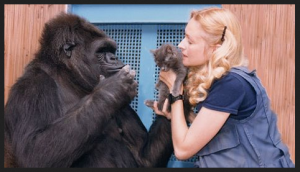Other animals, that is. Of course we humans are compulsive storytellers. We tell stories to entertain ourselves, to explain the world, to heal each other. Sometimes we call the storytelling ritual “therapy.”
But because storytelling requires language, and because until recently Western humans thought we were the only animals who had language, we also thought that we were the only storytellers.
Now the picture is getting more complex.
Recent scientific studies with animals from monkeys to parrots indicate language use that satisfies all but die-hard linguists. Koko the gorilla is perhaps the most famous for using sign language, and Alex the grey parrot, on the night before he died in 2007, told his trainer, “See you tomorrow. Be good. I love you.”
This week the Times reported on the work of Klaus Zuberbühler, a psychologist at the University of St. Andrews in Scotland, who studies the utterances of monkeys. He finds that Campbell’s monkeys string different calls together to make new meanings. For example, one call means “come to me,” but when followed by a different call, it means, “falling timber!”
If that’s not a story, it’s at least the start of one.
Dr. Zuberbühler has observed a similar achievement among putty-nosed monkeys that combine their “pyow” call (warning of a leopard) with their “hack” call (warning of a crowned eagle) into a sequence that means “Let’s get out of here in a real hurry.”
I feel cheered when I read about researchers like Dr. Zuberbühler, who is able to understand nuances of animal communication because he is willing to go beyond worn-out assertions about what other animals are and are not capable of. It’s a matter of training ourselves to perceive as other animals do, to pay close attention—to notice things to which we were previously blind, or deaf.
In our experience time and again, it’s a humbling experience to realize there is so much more information being passed in ways which hadn’t been noticed before.
Of course, Indigenous peoples have never thought otherwise. Carol Lee Sanchez, of the Laguna Pueblo, wrote in 1993 in what have become some of my all-time favorite words:
There are trees and grasses and flowers and birds and ants and bees waiting for you … to say hello to them—to call them sister, brother, cousin, or friend. They are your relatives; they hear your thoughts as you travel around your town or city.
With the complex social systems of most other animals, you have to think they are communicating in ways many humans just don’t recognize. Hearing thoughts, sending images, appearing in dreams—the repertoire of animal communication is broad, say Indigenous folks.
And speaking of dreams, I have to think of Bodhi when he sleeps. In his dreams he chases deer or maybe foxes—all the animals he’s not allowed to chase in daytime. His paws thrash, his eyes dart back and forth. He grunts in the dream version of barking.
I have no doubt he’s telling stories, if only to himself.


Priscilla, I think this is an important post. It reminds me that just because I don’t understand something or am not included in it, does not mean that it doesn’t have as much or greater significance than things that exist in my small personal world. I will try to be better at paying attention.
Thanks for stopping by, Mimi! I’m reminded of Michael Pollan’s (The Omnivore’s Dilemma) phrase about “the disease of human self-importance.” Just paying attention seems to be a good remedy for that illness!
Thanks for this. I’ve been thinking along the same lines myself but haven’t yet put it into words. I often wonder how much we humans miss because we don’t understand the how other species communicate. I know I misinterpret my dog all the time by anthropomorphizing instead of listening. And every time I do listen and gain some bit of insight, it feels sort of like a spiritual experience.
Liz, you’re highlighting a very important difference–between anthropomorphizing and listening. I wonder if it’s something like this: anthropomorphizing is assuming the other creature’s experience is the same as ours. Listening is assuming the other creature has experience but it may be way different from ours. I too experience the bit of insight as a spiritual moment because it is a moment of connection, truly understanding. Thanks for your comment!
Nice post… in my meandering ponderings on spirit and animism I recently started to understand being “alive” as being an entry point to an infinite universe of story. Certainly, my living, my being, is somehow involved in this infinite exploration of narrative… and in my relationship with other beings, non-human and human, we seem to share access to these infinite universes in many different ways. The fun is in exploring the ways, so that the stories become shared 🙂
Hi, Adam, thanks for stopping by. I too am exploring a new and deeper interest in story. If animism is, at heart, about relating and relationships, then narrative is the way of knowing. How else do we explore relationships except through story?